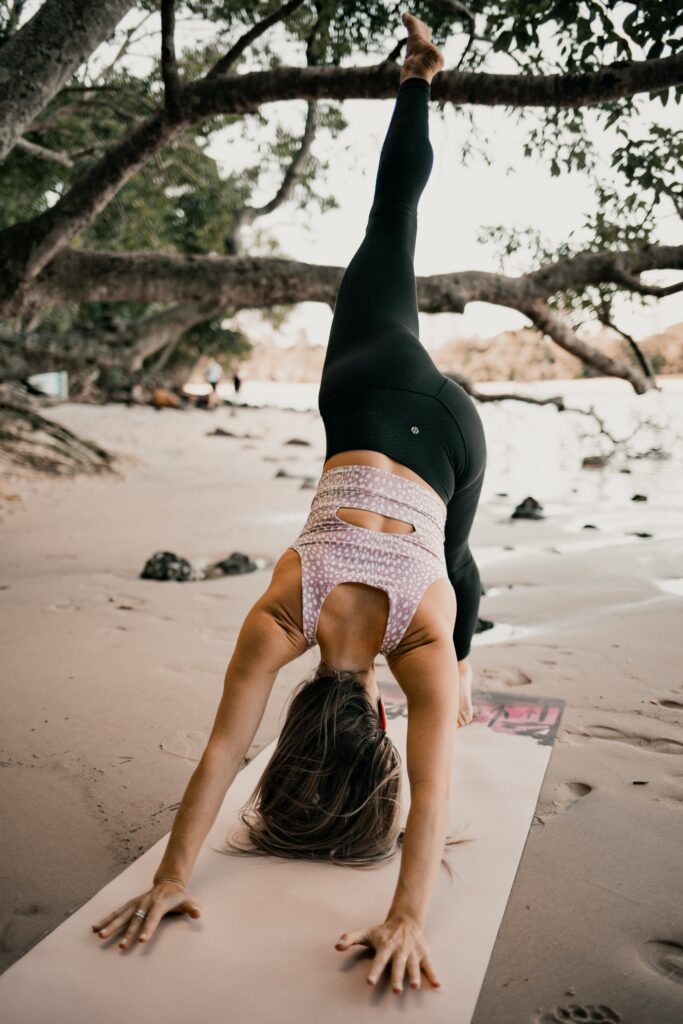Posture in Focus: Downward-Facing Dog

Let’s comprehensively unpack the features of Downward-Facing Dog to enjoy its full benefits in safety.
Perhaps one of the most famous yoga postures, Downward-Facing Dog is suitable for Beginners through to Advanced, and in addition to being a pose unto itself, is often used as a transition between poses.
Also known as
Adhomukha Svanasana
Adho = Down,
Mukha = Face,
Svana = Dog,
Asana = Pose
In English, it’s often abbreviated to simply Down Dog for ease.
Classification
Pascimatana (forward bends)
Benefits & Effects
Down Dog can be both energising and restorative. It brings warmth to the back of the body and shoulders, and lengthens the spine, but being a pose where the head is lower than the heart (it could also be fairly classified as an inversion), it also soothes and relaxes the nervous system.
Vinyasa krama, breath and drishti (How To…)
One of the classical ways to enter the posture is this:
- Stand in samasthiti.
- Inhaling, raise arms from the front, in line with ears, palms facing the front.
- Exhaling, bend forward and place palms by the sides of the feet, bending knees where necessary, head touching legs (if applicable), chin down.
- Holding the breath out, shift weight onto hands, lift legs back, landing feet together in a horizontal position (chaturanga dandasana), or simply step back into your plank posture.
- Inhaling, lift chest up while straightening elbows into Upward-Facing Dog
- Exhaling, lift hips up, move chest towards the legs, crown of the head down. Legs straight where possible, weight on hands and legs, heels reaching for the floor, chin down. Breathe naturally.
This vinyasa krama can be varied for different ages, abilities and other circumstances.
Alignment and things to watch for
- Upper arms should externally rotate
- Spine is straight, bend the knees a little if necessary
- Broadening across the upper back can take the crunch out of shoulders in ears
- The shape of your ankle joint can influence the heels’ ability to reach towards the floor, as much as hamstring length – forcing the heels down can injure your back. Some people’s heels will never reach the floor.
- Effort without a sense ease may result in holding your breath! Let breath be your guide.
Preparation and Counterposes
Gentle warm-ups may include for example:
Cat & Cow spinal movements
Wrist circles
Standing Forward Fold (Uttanasana)
Puppy Pose
A classic counterpose is the restful Childs Pose (Balasana)
Modifications and Adaptations
- Placing a blanket under the hands to take the pressure out of wrists
- Bent knees can help if you tend to round your spine in Down Dog, to take some of the stretch out of tight hamstrings, or if you have lower back pain.
- See also Contraindications below
Experiment with:
- Lift one leg straight up into 3-Limbed Stick (3-Legged Dog)
- Play with an inversion modification by placing hands on the floor with feet on a wall
- Try Revolved Down Dog by releasing one hand at a time to take hold of the opposite ankle, twisting the upper body.
Contraindications
People with neck, wrist or shoulder injury are best advised to practise under the supervision of an experienced teacher or yoga therapist.
This pose may not be suitable for people with low blood pressure, eye conditions such as glaucoma, or acid reflux issues, but may be adapted to have hands on a wall or chair instead of on the floor.
Written by Nicole Small, The Yoga Institute
Learn more about:



